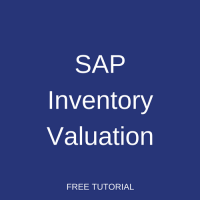 This tutorial which is part of our SAP MM course talks about SAP Inventory Valuation. You will learn about the concept of inventory valuation in SAP MM. We will talk about price control and accounting entries corresponding to standard and moving average prices. We will provide examples of calculating moving average and standard prices.
This tutorial which is part of our SAP MM course talks about SAP Inventory Valuation. You will learn about the concept of inventory valuation in SAP MM. We will talk about price control and accounting entries corresponding to standard and moving average prices. We will provide examples of calculating moving average and standard prices.
SAP provides different ways of managing inventory from the valuation point of view. In SAP ERP system, it is managed by price control indicator in Accounting 1 view of a material master record (transaction MM01). A material can be valuated either using Moving Average Price or Standard Price.
Price Control:
- V – Moving average price
- S – Standard price
Moving Average Price (V)
Every time when a new lot of stock is added to the existing stock, value of the total stock will be re-valuated based on the value of existing stock and a new stock.
Example
Let’s consider an example. Suppose that there is old stock of 10 Units of Item-A of value $200 (so, $20/unit) and now goods receipt has been done for 5 units of new stock of the same Item-A for value $150 (so, $30/unit). The value of the total stock (existing stock + new stock) will be calculated as following:
Price/unit = (200 + 150) / (10 + 5) = 350 / 15 = $23.33/unit
Total value of inventory => $(10 + 5) * 23.33 = $350
Any new consumption of inventory would be at $23.33/unit until new stock with different price comes to the inventory.
Standard Price (S)
The standard price is fixed during a time period. It means that inventory of a material is being evaluated at fixed price for a given period irrespective of the price of new stock being added.
Accounting Entries
Moving average price (V) and Standard Price (S) are different with respect to how SAP system handles price variances resulting from goods receipts and invoice receipts. Let’s consider two scenarios.
Moving Average Price (V)
Suppose the price in a material master is $25/unit and the total stock is 100 units. Next, a purchase order is created with the price $30/unit and quantity 50 units of this material. When users perform a goods receipt for this purchase order, the following accounting entries will be generated by the SAP system:
BSX [Inventory G/L Account] – $1500 – Debit
WRX [GR/IR Clearing G/L Account] – $1500 – Credit
That is, goods receipts are posted at goods receipts value, here $30/unit.
Standard Price (S)
Now, let’s imagine that the same material is managed using a standard price. Then, when posting a goods receipt for the PO, the SAP system will generate the following accounting entries:
BSX [Inventory G/L Account] – $1250 – Debit
WRX [GR/IR Clearing Account] – $1500 – Credit
PRD [Price Difference Account] – $250 – Debit
That is, variances are posted to PRD [Price Difference G/L Account], and thus, variation is not taken to inventory account when inventory is valuated using standard price control.
Material Type
In SAP system, we can set a particular price control (V or S) as a default value for a Material Type through settings made in transaction OMS2. When you create a new material using a particular Material Type, the SAP system will set the price control to either Moving Average Price (V) or Standard Price (S) automatically. However, you can always change it manually in Accounting 1 view of the material master.
Here are some standard material types and SAP recommendations regarding price control for them.
Moving Average Price (because prices of these material types fluctuate frequently as they are procured externally):
- ROH – Raw Materials
- HAWA – Trading Materials
Standard Price (because prices of these products do not fluctuate frequently):
- HALB – Semi-Finished Materials
- FERT – Finished Materials
Split Valuation
Having understood the inventory valuation based on price controls, let’s understand the concept of split valuation. Imagine that for some reasons, an organization wants to evaluate the material using different prices. For example, different batches of the same material have different valuation prices based on geographical origin, grades, etc. In SAP ERP, this feature is called Split Valuation and it allows to evaluate different batches of the same material at different prices.
Once Split Valuation is activated for your Valuation Area (Plant / Company Code), you can maintain different valuation prices in the Accounting 1 view of the material master record for Valuation Types.
Example:
Valuation Category: G – Geographical
Valuation Types: East & West
This way we can ensure that SAP inventory valuation of the same material can be procured with different prices when it comes from east and west geographical regions.
—
Did you like this SAP MM tutorial? Have any questions or comments? We would love to hear your feedback in the comments section below. It’d be a big help for us, and hopefully it’s something we can address for you in improvement of our free SAP MM tutorials.
Navigation Links
Go to next lesson: SAP Goods Receipt for Consumable Material
Go to previous lesson: SAP Material Valuation
Go to overview of the course: SAP MM Training

Please correct the following in document SAP Inventory Valuation:
From … “ROH – Trading Materials” to “ROH – Raw Materials”.
Thx
Updated, thanks for spotting this typo!